Unlocking your Productivity Potential: 4 Time Management Strategies
In today’s fast-paced world, time management has become an essential skill for success in both personal and professional endeavors. Whether you’re a student, a working professional, or an entrepreneur, effectively managing your time can greatly enhance your productivity and help you achieve your goals more efficiently.
In this article, we will explore four powerful time management strategies that will empower you to take control of your schedule, optimize your workflow, and unlock your full potential. By implementing these strategies into your daily routine, you’ll be able to maximize your productivity and accomplish more in less time. You can combine all those strategies with a Time Tracking Tool. So let’s dive in and discover the keys to unlocking your productivity potential!
1. The Eisenhower Decision Matrix
The Eisenhower Matrix, also referred to as Urgent-Important Matrix, helps you decide on and prioritize tasks by urgency and importance, sorting out less urgent and important tasks which you should either delegate or not do at all.
This is what the matrix looks like:
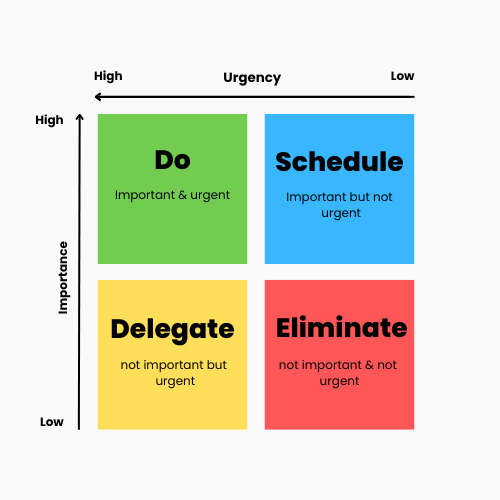
Here’s how to create the Eisenhower Matrix:
- Draw a grid with four quadrants to create four boxes.
- Across the top, write “Urgency” in the middle of both quadrant boxes. Then draw an arrow from right to left. Write “Low” at the right end and “High” at the left end.
- Going down the left side of the grid, write “Importance” in the middle of both quadrant boxes. Then draw an arrow bottom up. Write “Low” at the bottom end and “High” at the top end.
- Now for each task, you ask two questions, “Is this important?” and “Is this urgent?”
- Then, place each task into the box that matches your yes or no for each question.
Using the Eisenhower Matrix helps you visualize your time allocation and identify the quadrant with an overwhelming to-do list. Balancing tasks becomes the focus, and you must choose which quadrant to dedicate most of your time. Minimizing non-important and urgent tasks is essential. Prioritizing the important and not urgent quadrant fosters productivity without stress or burnout, ensuring a sustainable approach to responsibilities.
2. The 80/20 Rule
According to the 80-20 rule or also called Pareto Principle, just 20% of causes result in 80% of all outcomes. It is employed to identify the elements (usually in a business setting) that are most important to success and then concentrate on them to enhance outcomes. The principle also holds true in situations outside of business.
This is what the 80/20 Rule looks like:
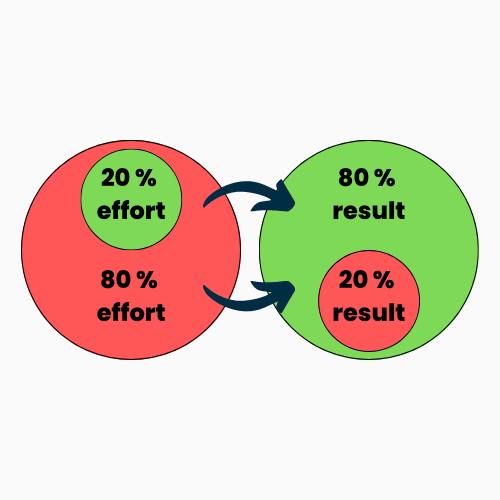
But how does the Pareto Principle work?
The Pareto Principle can be used to help you make the best decision in problem-solving circumstances.
To help to prioritize solutions, you can follow the steps below:
- Identify the problems that you are trying to find a solution to.
- Identify what the causes of these problems are.
- Categorize your problems into similar groups based on which ones have similar root causes. This can help you decide if one solution can resolve multiple problems.
- Assign a value to each of the problems based on their impact if they were or were not resolved. You could rate them between 1-10 if this helps.
- Develop a plan to focus on the top 20% of the problems that will result in 80% of the results.
A useful way to find out what you spend your time on is to log everything you do in a typical day or week. Go about your work normally and log everything you do without judgment. In doing so, you may find that you have many gaps where nothing gets done, or that you spend a lot of energy on tasks that are of little value. Review how many hours of your day you spend on tasks that help you achieve your goals. You may find that you spend little time on achieving your goals, but are often distracted by other tasks. A time log is valuable information that you can use to make better use of your day or week.
Using the Pareto Principle helps you prioritize your tasks, optimize resources, and improve overall efficiency. It provides a useful framework for understanding complex systems and identifying key areas for improvement.
3. Time Blocking
Time blocking is a time management technique that encourages you to divide your day into blocks of time. Each block is designed to perform a specific task or group of tasks and only those specific tasks. Instead of keeping an open to-do list that you’ll do to the best of your ability, you’ll start each day with a specific schedule that tells you what you’re going to do and when.
This is what Time Blocking looks like:
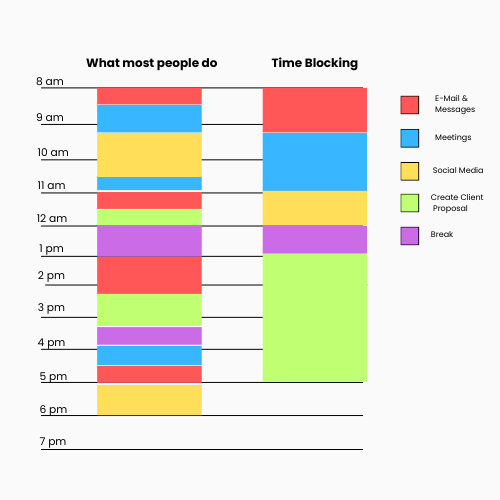
How to timeblock your calendar in only 3 steps:
1. Create a to do list
People are more likely to complete a task if they write down a specific place, date, and time.
To start blocking time, decide what you need to do next week. Try to be flexible, but you don’t have to think about every possible task. If something urgent happens within a week, that’s okay.
Schedule blocks of time to be adjusted each day as needed. But first, write down a list of important tasks for the coming week. Then prioritize this list. There are many ways to prioritize tasks. For example, you can use the Eisenhower method mentioned above. You can also review your annual goals and ask yourself what you can do next week to increase your chances of achieving them.
2. Guess how much time you’ll need to complete each task
You now have a task priority list. The next step is to guess how long each task will take. If the task requires more than one session to complete, consider breaking the task into small tasks and estimating how long each task will take.
Tip: If you are just starting out, you should double your score. Most people are overly optimistic about the timing of a task. The more often you use time blocking, the better you will get in time estimating.
3. Schedule an event on your calendar for each task
The last step in time blocking is to generate calendar events and assign them the name of the task you intend to accomplish during that specific period. However, the question arises: where should you arrange your work? There are multiple approaches to making this decision. Firstly, it is beneficial to align your work with your daily energy patterns instead of going against them. Throughout the day, most individuals experience fluctuations in productivity, energy levels, and creativity. Therefore, it is advisable to schedule demanding tasks when you are most energized, creative work during your peak creative periods, and so forth.
Using Time blocking helps you to enhance your productivity and time management. By deliberately selecting tasks and allocating specific time slots for them, this technique empowers you to take charge of your to-do list, minimize procrastination, and establish clear boundaries. Moreover, by structuring your schedule with time blocks, you can dedicate uninterrupted Focus Time during your workday, leading to increased efficiency and concentration.
4. The Pomodoro Technique
The pomodoro technique is a time management system designed to enhance your concentration and productivity. Instead of fighting against time, it promotes working within specific time intervals. By simply working in 25-minute intervals known as pomodoro sessions and taking 5-minute breaks in between, you can end each day with a sense of achievement. The pomodoro technique has gained popularity among freelancers who want to track their time, students aiming to study more efficiently, and individuals seeking self-improvement in their professional endeavors or personal projects.
How the Pomodoro Technique works:
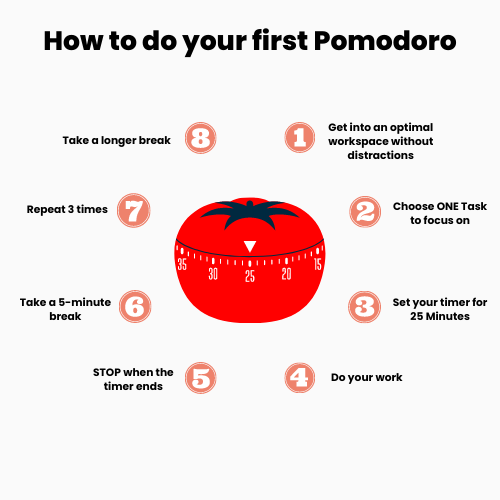
Plan your Pomodori in advance:
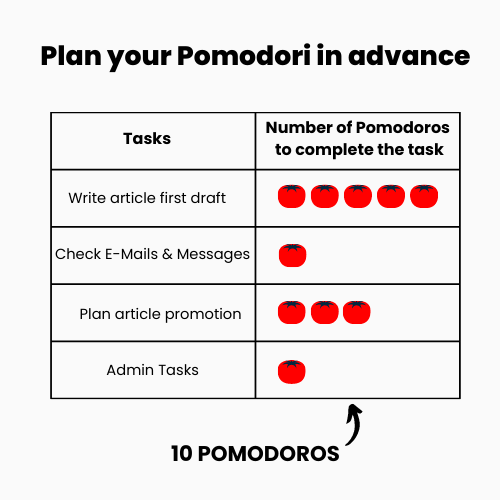
Further Tips:
Adjust the duration of Pomodoros to fit your work habits: You have the flexibility to customize the length of Pomodoro sessions based on your preferences. The suggested 25-minute work time is just one example of the Pomodoro technique. You can opt for longer breaks or shorter work intervals if it suits you better. As long as you maintain the work-break sequence, you can still enjoy the benefits of the technique.
Combine it with other strategies: If you are fond of organizational and productivity strategies, you can integrate them with the Pomodoro technique. Use a strategy to organize your tasks and then tackle them using the Pomodoro method.
Utilize Pomodoros when they are most beneficial: It’s not necessary to employ Pomodoro sessions throughout your entire workday. Apply this method when you find it especially helpful, particularly when working on projects involving multiple concurrent tasks. If your productivity tends to fluctuate during the day, consider implementing the Pomodoro technique during your peak periods.
The Pomodoro Technique can be a valuable tool against planning fallacy and can be a useful tool for efficient Time Management. When you start working in short, timed sessions, time is no longer an abstract concept, but a concrete event.
This blog post delves into the importance of time management in today’s fast-paced world and how it can significantly impact personal and professional success. The article introduces four powerful time management strategies and explores how they can empower individuals to take control of their schedules, enhance productivity, and achieve their goals more efficiently. By combining these strategies and potentially using a Time Tracking Tool like Kimai Mobile, you can optimize your time management skills, leading to more efficient workflows, improved concentration, and better overall productivity. You can customize these techniques to fit your unique needs and energy patterns, ultimately unlocking your productivity potential and achieving your goals with greater ease and satisfaction.


